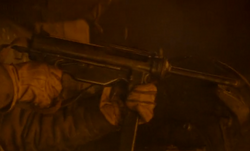| M3A1 "Grease Gun" | |

| |
| Designer | George Hyde |
| Designed | 1942 |
| Used by | Norman American Soldiers |
| Calibre | .45ACP |
The M3 was an American .45-caliber submachine gun adopted for U.S. Army service on 12 December 1942, as the United States Submachine Gun, Cal. .45, M3. The M3 was chambered for the same .45 round fired by the Thompson submachine gun, but was cheaper to produce, lighter, and more accurate. The M3 was commonly referred to as the "Grease Gun" or simply "the Greaser" owing to its visual similarity to the mechanic's tool of that name.
Intended as a replacement for the expensive and complicated Thompson series of submachine guns, the M3 and its improved successor, the M3A1 began to replace the Thompson in first-line service in late 1944 and early 1945. Due to delays caused by production issues and approved specification changes, the M3/M3A1 saw relatively little combat use in World War II.
The M3A1 Grease Gun was seen in Fury, in use by several soldiers including Norman Ellison.
History[]
In December 1944, in response to field requests for further improvements to the basic M3 design, an improved, simplified variant of the M3 was introduced, the M3A1. Some 15,469 M3A1 submachine guns were produced before the end of World War II.
It was originally hoped that the M3 could be produced in numbers sufficient to cancel future orders for the Thompson submachine gun, and to allow the army to gradually withdraw the Thompson from front-line service. However, due to unforeseen production delays and requests for modifications, the M3 never replaced the Thompson during World War II, and purchases of the Thompson continued until February 1944. A total of 622,163 M3/M3A1 submachine guns of all types were assembled by the end of World War II, by which time the Thompson, at over 1.5 million guns produced, outnumbered the M3 and M3A1 in service by a factor of nearly three to one.
The M3 and M3A1 were largely withdrawn from U.S. frontline service in 1957, but continued to be used until the mid-1990s by armored vehicle crews and truck drivers. During the mid 1970s tank drivers of the 1st Battalion 67th Armored attached to the 2nd Armored Division were issued the M3A1, because of its size and portability. During the 1991 Gulf War, drivers of the 19th Engineer Battalion attached to the 1st Armored Division were equipped with the M3A1 as part of their vehicle TOE.
Design details[]
The M3 was an automatic, air-cooled blowback-operated weapon that fired from an open bolt. Constructed of plain .060-in. thick sheet steel, the M3 receiver was stamped in two halves that were then welded together. The M3 was striker-fired, with a fixed firing pin contained inside the bolt. The bolt was drilled longitudinally to support two parallel guide rods, upon which were mounted twin return (recoil) springs. This configuration allowed for larger machining tolerances while providing operating clearance in the event of dust, sand, or mud ingress. The M3 featured a spring-loaded extractor which was housed inside the bolt head, while the ejector was located in the trigger group. Like the British Sten, time and expense was saved by cold-swaging the M3's barrel.
Operating mechanism[]
The M3 operating sequence is as follows: the bolt is cocked to the rear using the cocking handle located on the right side of the ejector housing. When the trigger is pulled, the bolt is driven forward by the recoil springs, stripping a round from the feed lips of the magazine and guiding the round into the chamber. The bolt then continues forward and the firing pin strikes the cartridge primer, igniting the round, resulting in a high-pressure impulse, forcing the bolt back against the resistance of the recoil springs and the inertial mass of the bolt. By the time the bolt and empty casing have moved far enough to the rear to open the chamber, the bullet has left the barrel and pressure in the barrel has dropped to a safe level. The M3's comparatively low cyclic rate was a function of the relatively low pressure generated by the .45 ACP round, a heavy bolt, and recoil springs with a lighter-than-normal compression rate.
